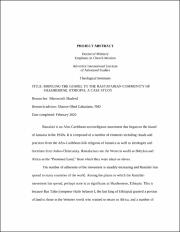| dc.description.abstract | Rastafari is an Afro-Caribbean socioreligious movement that began on the island of Jamaica in the 1930s. It is composed of a number of elements including rituals and practices from the Afro-Caribbean folk religions of Jamaica as well as ideologies and doctrines from Judeo-Christianity. Rastafarians see the Western world as Babylon and Africa as the “Promised Land,” from which they were taken as slaves.
The number of adherents of the movement is steadily increasing and Rastafari has spread to many countries of the world. Among the places to which the Rastafari movement has spread, perhaps none is as significant as Shashemene, Ethiopia. This is because Ras Tafari (emperor Haile Selassie I, the last king of Ethiopia) granted a portion of land to those in the Western world who wanted to return to Africa, and a number of
Rastafarians from different countries have repatriated to Shashemene and formed a community there.
There have been a number of studies conducted on the Rastafari movement but mostly in terms of anthropology and culture. However, when one considers the Rastafari movement in the context of the Great Controversy and the mandate of fulfilling the great commission of making disciples of all nations, the Adventist Church must do something to minister to this people group for whom Christ has died. Regrettably, this has not been the case, especially in terms of missiological research seeking to reach Rastafarians.
To address this situation, this study presents the background, development, worldview, and religious ideologies of the Rastafari movement in order to (a) better understand Rastafarians and (b) suggest missiological strategies and methods of presenting the everlasting Gospel to them. It also presents a qualitative case study on Christian converts from the Rastafarian community of Shashemene, Ethiopia. Subsequent to that, the data acquired from literary sources and interviews were analyzed, and a systematic strategy is presented to bring the Gospel to the Rastafarians of Shashemene. This strategy highlights the bridges that can be used and the pitfalls to be avoided when ministering to the Rastafarians of Shashemene. | en_US |

